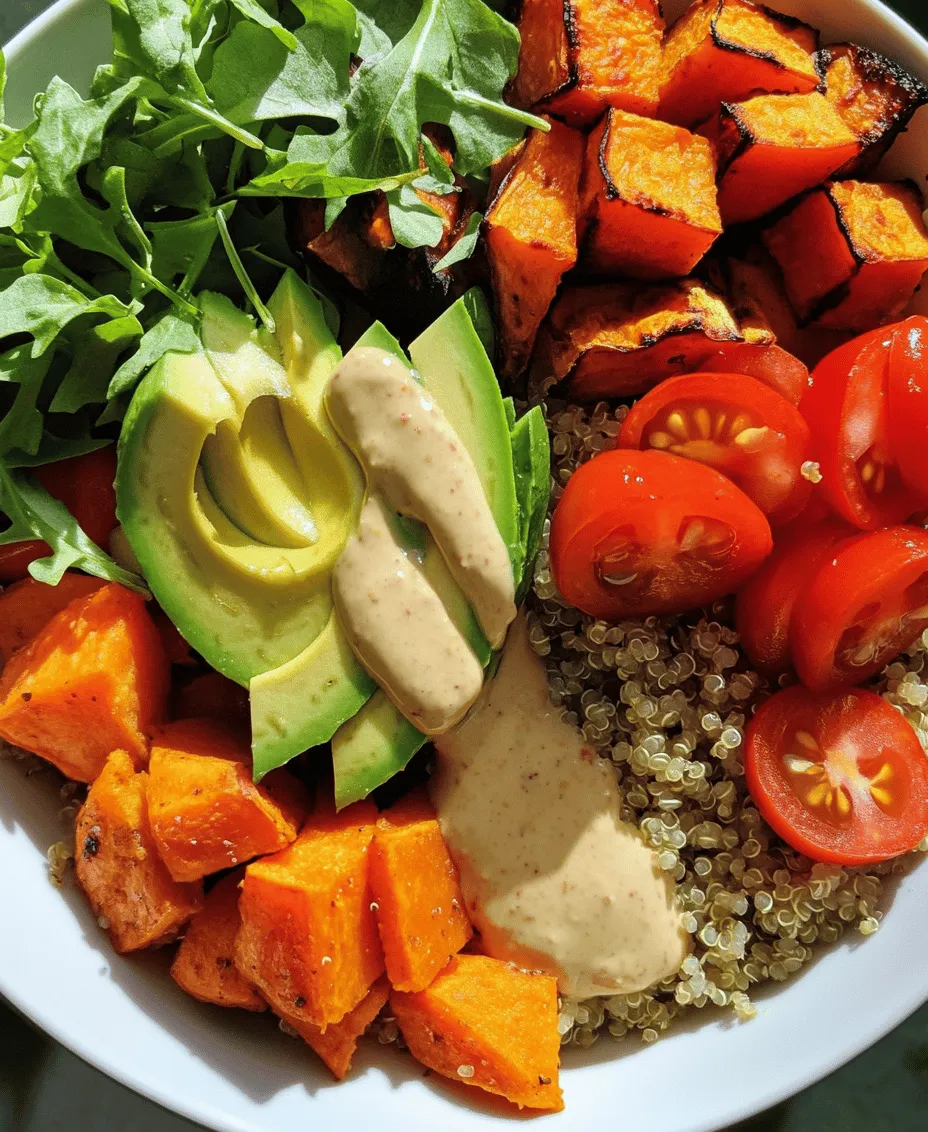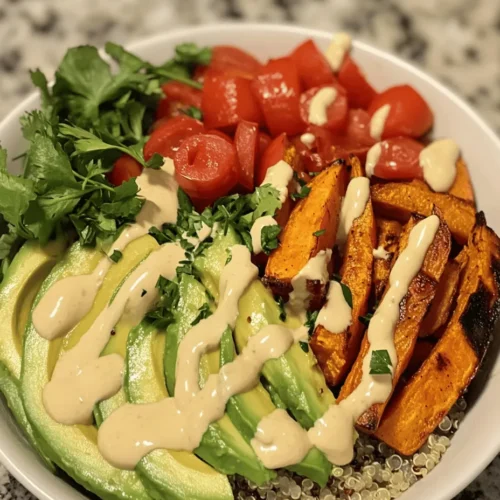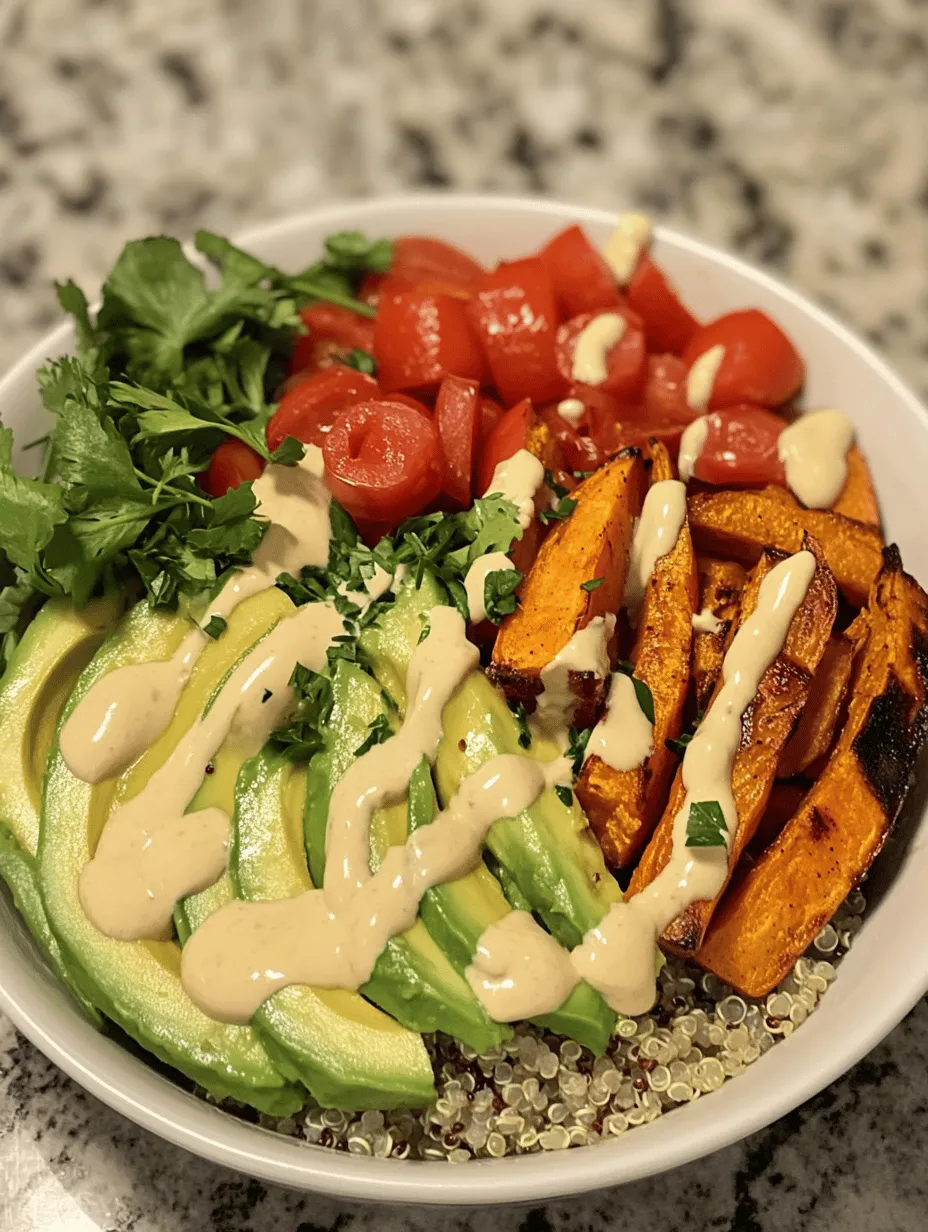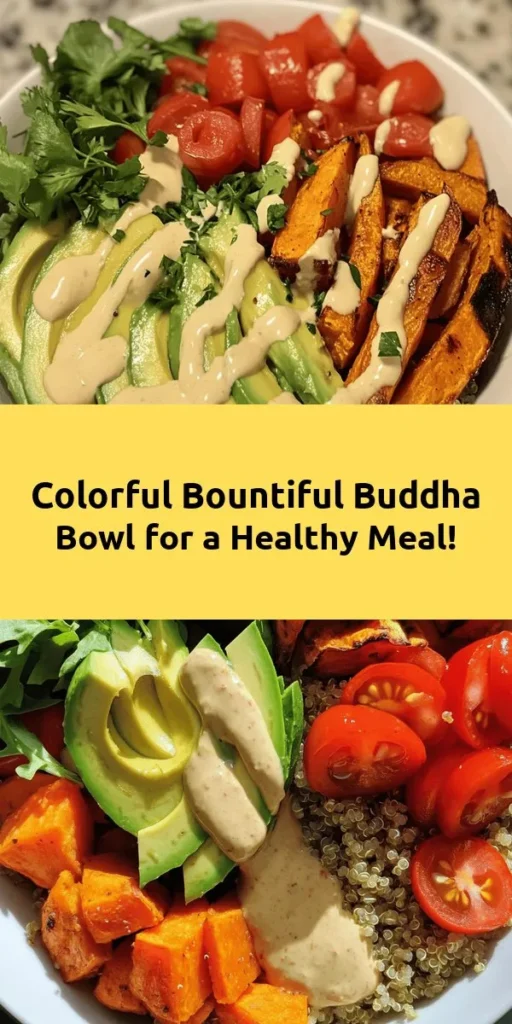Introduction
In recent years, the Buddha bowl has emerged as a beloved culinary trend, celebrated for its colorful presentation and nutritious ingredients. The concept of the Buddha bowl is rooted in the idea of balance and variety, embodying a harmonious blend of flavors, textures, and nutrients. Often characterized by a base of grains, a medley of vegetables, proteins, and a vibrant dressing, these bowls are as visually appealing as they are satisfying. Originating from ancient Buddhist traditions, where monks would carry bowls filled with whatever food was offered to them, the modern interpretation encourages creativity and personal expression in meal prep.
One of the standout features of Buddha bowls is their versatility. They can be easily customized to accommodate various dietary preferences, making them a popular choice for vegans, vegetarians, and omnivores alike. The Bountiful Buddha Bowl, in particular, is a vibrant, wholesome meal option that showcases a delightful array of ingredients, ensuring that each bite is packed with nutrition and flavor. This recipe not only satisfies the taste buds but also nourishes the body, making it a perfect choice for lunch or dinner.
Understanding the Bountiful Buddha Bowl
At its core, a Buddha bowl is all about balance. A well-constructed bowl includes a variety of components that create a satisfying meal: grains, proteins, vegetables, healthy fats, and sauces or dressings. The beauty of the Buddha bowl lies in its flexibility; you can mix and match ingredients based on what you have on hand or what’s in season, ensuring that every meal feels fresh and exciting.
The Bountiful Buddha Bowl exemplifies this principle, featuring a medley of ingredients that not only complement each other in taste but also in nutritional value. The key to a successful Buddha bowl is achieving a harmonious balance between flavors and textures. The nuttiness of quinoa, the creaminess of avocado, the sweetness of roasted sweet potatoes, and the crunch of fresh vegetables come together to create a delightful culinary experience.
In addition to flavor, the use of fresh, seasonal ingredients plays a crucial role in the overall success of your Buddha bowl. Seasonal produce not only tastes better but is also more nutritious, as it is harvested at its peak ripeness. This emphasis on freshness ensures that your Bountiful Buddha Bowl is not just a meal but a celebration of the bounty that nature has to offer.
Ingredients Breakdown
To create a truly Bountiful Buddha Bowl, we will use a variety of wholesome ingredients, each contributing unique flavors and nutritional benefits. Here’s a closer look at each component of this vibrant dish:
Quinoa
Quinoa serves as the foundation of our Buddha bowl, providing a gluten-free grain that is rich in protein and fiber. This superfood is often referred to as a “complete protein” because it contains all nine essential amino acids, making it an excellent choice for those seeking plant-based protein sources. Additionally, quinoa is packed with essential nutrients, including magnesium, phosphorus, and B vitamins, ensuring that your meal is as nutritious as it is delicious.
Chickpeas
Chickpeas, also known as garbanzo beans, are a fantastic addition to our Bountiful Buddha Bowl. They are high in protein and fiber, which not only enhances satiety but also supports digestive health. Incorporating chickpeas into your meal helps to keep you feeling full longer, making them an ideal choice for those looking to maintain a healthy weight. Their nutty flavor and firm texture provide a delightful contrast to the other ingredients in the bowl.
Sweet Potato
Sweet potatoes are a flavorful and nutritious ingredient that adds a hint of sweetness to our Buddha bowl. Rich in vitamins A and C, as well as antioxidants, sweet potatoes contribute to overall health and wellness. Their vibrant orange color is a testament to their beta-carotene content, which is known for promoting healthy skin and vision. Roasting sweet potatoes enhances their natural sweetness and creates a tender, caramelized texture that complements the other ingredients beautifully.
Kale
Kale is a nutrient-dense leafy green that deserves a spot in our Bountiful Buddha Bowl. Packed with vitamins A, C, and K, kale is a powerhouse of nutrients that supports immune function, bone health, and overall well-being. Its slightly bitter flavor and hearty texture stand up well against the other ingredients, adding depth to the bowl. Whether you choose to massage the kale with a bit of olive oil or enjoy it raw, this green leafy vegetable is a must-have for a balanced meal.
Avocado
Avocado brings a creamy texture and healthy fats to the Bountiful Buddha Bowl, making it a favorite among health-conscious eaters. Rich in monounsaturated fats, avocados are known for their heart-healthy properties and ability to promote satiety. They also contain a variety of vitamins and minerals, including vitamins E and K, potassium, and folate. The addition of avocado not only enhances the flavor profile of the bowl but also boosts its nutritional value significantly.
Red Bell Pepper
Red bell peppers add a pop of color, crunch, and sweetness to our Buddha bowl. These vibrant vegetables are an excellent source of vitamin C, which is essential for immune function and skin health. Their crisp texture and sweet flavor balance the earthiness of the grains and beans, providing a refreshing contrast. Slicing red bell peppers into strips or dicing them adds visual appeal and ensures that you get a burst of flavor in every bite.
Cherry Tomatoes
Cherry tomatoes offer a fresh burst of sweetness and acidity to the Bountiful Buddha Bowl. These bite-sized fruits are high in vitamins C and K, as well as antioxidants like lycopene, which may support heart health. Their juicy texture and vibrant color enhance the overall presentation of the bowl, making it not only delicious but also visually enticing. Tossing in a handful of halved cherry tomatoes creates a delightful contrast with the other ingredients.
Tahini
Tahini serves as the creamy, nutty dressing that ties all the flavors of the Bountiful Buddha Bowl together. Made from ground sesame seeds, tahini is rich in healthy fats, protein, and essential minerals like calcium and iron. Its rich and slightly bitter flavor complements the sweetness of the roasted vegetables and the earthiness of the grains. Drizzling tahini over the bowl not only adds depth of flavor but also enhances the overall creaminess of the dish.
Fresh Herbs
Fresh herbs, such as cilantro or parsley, elevate the flavor and presentation of the Bountiful Buddha Bowl. These vibrant greens add a burst of freshness and aroma that can brighten up any dish. Additionally, herbs are packed with antioxidants and various nutrients that can support overall health. Sprinkling fresh herbs on top of your bowl not only enhances the flavor but also adds a beautiful finishing touch to your meal.
Preparation Steps
Creating the Bountiful Buddha Bowl is an enjoyable and straightforward process that allows you to explore your culinary creativity. Below are the initial steps for preparing this delicious meal:
Step 1: Preheat the Oven
The preparation begins with preheating your oven to 425°F (220°C). This high temperature is ideal for roasting the sweet potatoes and chickpeas, allowing them to develop a crispy exterior while remaining tender on the inside. Roasting brings out the natural sweetness of the sweet potatoes and enhances the flavor of the chickpeas.
Step 2: Prepare the Sweet Potatoes
While the oven is preheating, it’s time to prepare the sweet potatoes. Start by washing and peeling the sweet potatoes, then cut them into bite-sized cubes. The smaller the pieces, the quicker they will roast, so aim for uniform sizes to ensure even cooking. Once cut, toss the sweet potato cubes with a drizzle of olive oil, salt, and pepper to enhance their flavor. Spread them out in a single layer on a baking sheet lined with parchment paper, ensuring they have enough space to roast evenly.
Step 3: Roast the Chickpeas
Next, it’s time to prepare the chickpeas. If you’re using canned chickpeas, be sure to rinse and drain them thoroughly before using. Pat them dry with a clean towel to remove excess moisture, which helps them achieve a crispy texture when roasted. In a bowl, toss the chickpeas with olive oil, salt, and any desired spices, such as paprika or garlic powder, to add an extra layer of flavor. Spread the seasoned chickpeas on a separate baking sheet lined with parchment paper.
Step 4: Roast the Sweet Potatoes and Chickpeas
Once the oven is preheated, place both baking sheets in the oven. Roast the sweet potatoes for about 25-30 minutes, flipping them halfway through to ensure even browning. The chickpeas will take approximately 20-25 minutes to become crispy. Keep an eye on both ingredients as they roast, and remove them from the oven when they are golden brown and tender. Allow them to cool slightly while you prepare the other components of the Buddha bowl.
Step 5: Prepare the Quinoa
While the vegetables are roasting, prepare the quinoa. Rinse 1 cup of quinoa under cold running water in a fine-mesh sieve to remove its natural coating, called saponin, which can impart a bitter taste. In a medium saucepan, combine the rinsed quinoa with 2 cups of water or vegetable broth for added flavor. Bring to a boil, then reduce the heat to low, cover, and simmer for about 15 minutes or until the quinoa is fluffy and all the liquid has been absorbed. Once cooked, remove from heat and let it sit covered for a few minutes before fluffing it with a fork.
These initial steps lay the groundwork for creating your Bountiful Buddha Bowl. With the fresh ingredients roasted and the quinoa prepared, you are now ready to assemble your vibrant and nourishing meal. The next part of this recipe will delve into assembling the bowl and adding the finishing touches that will elevate this dish to a new level of deliciousness. Stay tuned for the continuation of this delightful culinary journey!

Cooking Quinoa in Vegetable Broth for Added Flavor
To start your Bountiful Buddha Bowl, cooking the quinoa in vegetable broth is a game changer. This simple step infuses the quinoa with a rich, savory flavor that serves as a perfect base for your bowl. Begin by rinsing 1 cup of quinoa under cold water to remove its natural coating, called saponin, which can impart a bitter taste.
In a medium saucepan, combine the rinsed quinoa with 2 cups of low-sodium vegetable broth. Bring the mixture to a boil over medium-high heat, then reduce the heat to low, cover, and let it simmer for about 15 minutes or until all the liquid is absorbed. Once cooked, fluff the quinoa with a fork and let it sit for an additional 5 minutes. This step ensures that your quinoa will be light and fluffy, providing the perfect canvas for the vibrant toppings that follow.
Combining Fresh Vegetables and Chickpeas for a Nutritious Mix
While the quinoa is cooking, it’s time to prepare the fresh vegetables and chickpeas that will contribute to the nutritional powerhouse that is your Buddha Bowl. Begin by selecting a variety of colorful vegetables to create a vibrant and appealing dish. Some excellent choices include:
– Spinach or Kale: For a nutrient-dense leafy green base, use a generous handful of fresh spinach or kale. These greens are packed with vitamins A, C, and K.
– Bell Peppers: Slice up some red, yellow, or green bell peppers for a sweet crunch and a boost of vitamin C.
– Cucumbers: Dice cucumbers for a refreshing, hydrating element.
– Carrots: Shred or julienne carrots for added sweetness and a pop of color.
– Cherry Tomatoes: Halve these sweet morsels for a juicy burst of flavor.
In addition to these vegetables, add 1 can (15 ounces) of drained and rinsed chickpeas for a significant protein boost. Chickpeas are an excellent source of plant-based protein and fiber, making them a perfect complement to your Buddha Bowl. Toss the vegetables and chickpeas together in a large bowl, seasoning them lightly with salt, pepper, and a squeeze of lemon juice for brightness.
Making the Tahini Dressing for a Creamy Finish
No Buddha Bowl is complete without a rich and creamy dressing, and tahini dressing is a fantastic choice that brings everything together. To make your tahini dressing, combine the following ingredients in a small bowl:
– 1/4 cup tahini: This sesame seed paste is not only creamy but also packed with healthy fats and protein.
– 2 tablespoons lemon juice: Fresh lemon juice brightens the flavors.
– 1 tablespoon maple syrup: For a touch of sweetness that balances the tahini’s richness.
– 1 clove garlic, minced: Adds a punch of flavor.
– Water: Gradually add water until you reach your desired consistency, typically 2-4 tablespoons.
Whisk all the ingredients together until smooth and creamy. Taste and adjust seasoning as needed, adding more lemon juice, salt, or maple syrup according to your preference. This dressing can be made ahead of time and stored in the refrigerator for up to a week, making it a versatile addition to many meals.
Assembling the Bowl for a Visually Appealing Presentation
Now that all components are prepared, it’s time to assemble your Bountiful Buddha Bowl. Start with a generous scoop of the cooked quinoa as your base, filling about one-third of your bowl. Next, artfully arrange your fresh vegetable and chickpea mixture on top of the quinoa, creating sections of each ingredient to enhance visual appeal.
Drizzle your creamy tahini dressing over the top, allowing it to cascade down over the vegetables. For added texture and flavor, consider garnishing with toppings such as:
– Sliced avocado: For creaminess and healthy fats.
– Sesame seeds: For a nutty crunch.
– Fresh herbs: Such as cilantro or parsley for a fresh finish.
– Red pepper flakes or za’atar: For a touch of heat or earthiness.
Cooking Tips for Success
Suggestions for Customizing the Buddha Bowl
One of the best aspects of the Bountiful Buddha Bowl is its versatility. Here are some tips for customizing your bowl to suit your tastes and dietary needs:
– Variations in Protein Sources: If you prefer a different protein source, consider swapping out chickpeas for cubed tofu or tempeh. Both options can be marinated and baked or sautéed to add additional flavor.
– Seasonal Vegetable Swaps: Take advantage of seasonal produce for the freshest flavors. In summer, try adding zucchini or corn, while in fall, roasted sweet potatoes or Brussels sprouts work wonderfully.
– Creative Dressing Alternatives: While tahini dressing is a classic, feel free to experiment with different dressings. A lemon-tahini sauce, peanut dressing, or even a yogurt-based dressing can change the flavor profile entirely.
Nutritional Value
The Bountiful Buddha Bowl is not only delicious but also packs a punch in terms of nutrition. Here’s a breakdown of its health benefits:
– Caloric Breakdown and Macronutrient Information: On average, a serving of this Buddha Bowl contains approximately 450-500 calories, depending on portion sizes and added ingredients. It includes about 20 grams of protein, 15 grams of healthy fats, and 70 grams of carbohydrates, making it a well-rounded meal.
– Supports a Balanced Diet: This meal is ideal for vegetarians and vegans, providing a complete protein source when quinoa and chickpeas are combined. It also contains a good mix of essential vitamins and minerals, making it a nourishing option for any meal.
– Importance of Fiber and Healthy Fats: The combination of quinoa, chickpeas, and vegetables provides an excellent source of dietary fiber, which supports digestive health. The healthy fats from tahini and any avocado you add contribute to satiety and are beneficial for heart health.
Serving Ideas
When it comes to serving your Bountiful Buddha Bowl, consider these ideas to elevate your meal experience:
– Ideal Complementary Dishes: Pair your Buddha Bowl with a side of crusty whole-grain bread or a light soup, such as a miso soup or vegetable broth, to create a complete dining experience.
– Beverage Pairings: A refreshing herbal iced tea or sparkling water with a slice of lemon makes for a perfect accompaniment. For a more indulgent option, consider a light white wine or a crisp cider.
– Presentation Tips: If you’re entertaining guests, serve the Buddha Bowls in individual servings for a more elegant presentation. Alternatively, consider creating a Buddha Bowl bar where guests can customize their bowls with a variety of toppings and dressings, making it interactive and fun.
Conclusion
The Bountiful Buddha Bowl is not just a meal; it’s a celebration of flavors, colors, and nutrition. With the ability to customize ingredients based on personal preferences and seasonal availability, this dish encourages creativity in the kitchen. The health benefits, including high protein and fiber content, make it an excellent choice for anyone looking to maintain a balanced diet.
As you explore the world of Buddha Bowls, allow yourself to enjoy the process of experimenting with different combinations of ingredients and dressings. Invite your friends and family to join you in this culinary adventure, and relish in the joy of creating personalized bowls that cater to everyone’s tastes. Whether you’re enjoying a quiet lunch at home or hosting a vibrant dinner party, the Bountiful Buddha Bowl is sure to impress.



